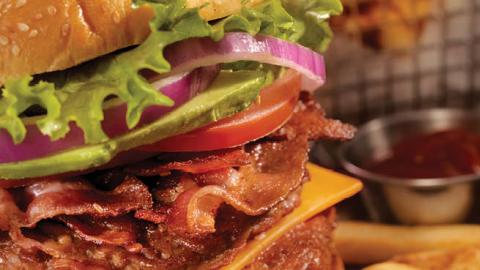The year 2020 was brutal for U.S. restaurants, with nearly one in six — over 110,000 establishments – out of business or closed for the long term, and survival being Job One. Yet as the pandemic eases and cities re-open, all of us are cheering our favorite restaurants’ return. But in their efforts to regain customers, many chains are once again pandering to our worst instincts: bringing back their least healthy, highest-calorie menu items. It’s time they adopt a new playbook, one that demonstrates they are not oblivious to the growing number of customers who want healthier options.
Weary of cooking at home, consumers are eager to dine out again. However, what awaits them are the same fatty, caloric foods they binged on while quarantining, just served to them by someone else. A recent food industry article highlighted that “oversized protein” items are the rage in the quest for new “signature” menu offerings. Among the more notable newcomers are IHOP’s Bacon Obsession menu, the Candied Bacon Mother Cruncher chicken sandwich at Checkers & Rally’s, and Red Lobster’s “Codzilla,” eight ounces of fried cod spilling out from a brioche bun, that actually beats the Big Mac’s calorie count by 50%.
Barry Popkin, renowned obesity researcher at the University of North Carolina at Chapel Hill, says these new items show that restaurants care more about profit than their customers’ well-being. “During the Covid lockdown Americans increasingly turned to junk food, sugary beverages and alcohol, and weights soared upward,” Popkin told me. “Currently we have the restaurant equivalent of that. Now that folks are out and about, restaurants are fighting for the crowd that wants to save a buck … and driving another nail into our increasing obese, diabetic, hypertensive disabled population. These restaurants are putting profit first and disabling America.”
Restaurant insiders say these proprietary, monstrous offerings are an often-used tactic. Tom Ryan, former chief concept officer at McDonald’s and founder of Smashburger, told me that “these are promotional items that try to attract patrons but generally don’t stick.”
So why the gimmickry? It could be a desperate Hail Mary pass by older, dying restaurant chains catering to a base that wants taste, large portions and low prices. This playbook really needs to be tossed out. Many chains are in denial that consumer tastes are changing and that more people really want to eat healthier, especially the largest generational cohort: millennials.
If ever there was a wake-up call to the food industry about the link between excessive consumption and consumer health, Covid-19 was it. Apparently that memo has not been received by the bulk of the restaurant trade.
Obesity rates spiked to 42.4% in the U.S. pre-Covid. Then came the pandemic. Not only did people gain an average of a half pound every 10 days while in quarantine, but those with obesity exhibited a 48% higher death rate from Covid-19. The problem is only getting worse, and restaurants have played a major role in padding the pounds onto customers’ waistlines.
So in good conscience, how can restaurants continue to push mega-portions onto their patrons? Consider that a study by FMCG Gurus, a global market research firm, found that 80% of consumers around the world want to eat and drink healthier to buttress their health and immunity after the pandemic. Rather than fight this trend, the restaurant industry should be riding it and leading the charge. They should be finding tasty and creative ways to serve these newly health-conscious customers, rather than tempting them to backslide.
Restaurants often argue that “value” matters to many customers, and that the only way to deliver that is via larger portions. While that may be one interpretation, there are many ways to give patrons what they want.
Witness one exciting new restaurant chain concept: Barcelona. This tapas-inspired chain, which has expanded beyond its Connecticut base, has figured out a way to satisfy emerging needs by offering a variety of novel tastes, a unique dining experience, healthier options and right-sized portions, many of them under $10. These in particular appeal to millennials who are now driving trends in the restaurant sector. And for a fast-food item, Chick-Fil-A ‘s signature sandwich weighs in at just 440 calories, about half that of “Codzilla,” and costs less than $5. Chick-Fil-A has been one of the most successful chains over the past few years, and it’s doing many things right.
So what should the restaurant industry be doing?
* Offer “signature” items that aren’t belly busters. As Barcelona and Chick-Fil-A show, restaurants don’t need to be excessive to build a following.
* Deliver foods your patrons really want. Tasty foods that are healthier and right-sized is where the market is going. Millennials in particular are driving this trend. Ignoring their needs is a recipe for failure.
* Step up and (finally) make a commitment to shave calories and portion sizes off menus. Packaged foods companies have made several pledges to eliminate unhealthy ingredients and shrink portion sizes. Restaurants have been noticeably absent. Doing so would be good for their customers along with sustaining their patronage.
The pandemic has shone a light on the impact that poor diets and foods can have on consumer health. Restaurants need to do their share. Restaurant patrons are increasingly clamoring not for Codzilla, but for new experiences and healthier foods. Not delivering will hurt an industry just getting back on its feet.
Read in Forbes




















